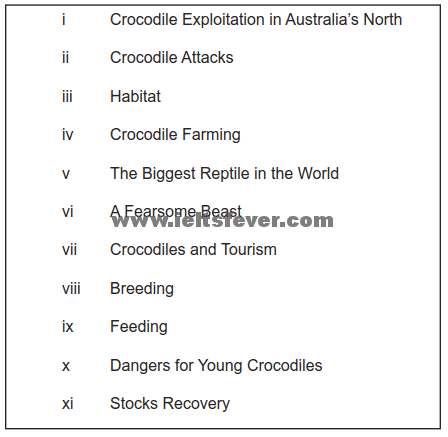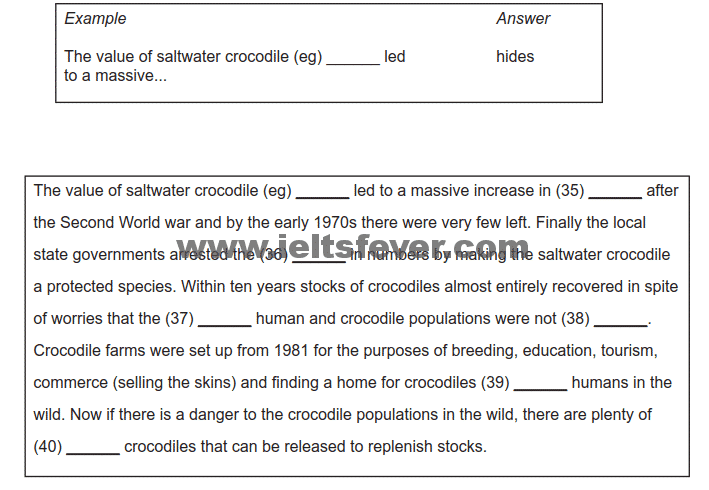SECTION 3 Questions 29 – 40
Read the following passage and answer Questions 29 – 40.
The Saltwater Crocodiles of Australia
A
What’s the world’s largest reptile? It’s a saltwater crocodile. Crocodiles have been on this planet for tens of millions of years – far longer than us! Many animals are unfairly feared through ignorance as a danger to humans but the saltwater crocodiles wholly deserve the fear and the respect given to them by people living near them. The large saltwater crocodile has taken the lives of many unsuspecting men, women, children, their pets and livestock. By maturity saltwater crocs can reach between 20 and 23 feet. An average length for full grown males is about 17 feet and females rarely exceed 10 feet.
B
The saltwater crocodiles are native to many estuarine Indo Pacific regions and for this reason they are often known as Estuarine Crocodiles. They range from China all the way through Australia and up into the Indian Ocean. The saltwater crocodile is found along Australia’s northern coast and up to 200km inland. As the name suggests these crocodiles are mainly found in estuaries where tidal rivers meet the sea. This watery habitat is often mangrove lined. They can also be sometimes found in the open sea or inland in freshwater swamps and billabongs. Saltwater crocs are usually found though in brackish waters where the seawater meets freshwater.
C
Saltwater crocs hunt by waiting close to the water’s edge and pounce upon their victims in the blink of an eye. The usual prey of younger crocs is smaller animals such as fishes and crustaceans. Adults can also attack and eat larger animals by overpowering them and then drowning them. After the prey is dead, the croc will break up the prey into smaller pieces by violent flicking of the head to snap or break bones or twisting and rolling the body. Larger crocs will also take carrion (dead animals) if hungry.
D
Nesting takes place in freshwater areas in the wet season (Between November and March) after the males fight for the females. Raised nests are constructed and into these nests between 25 and 90 eggs will be deposited. Females will remain near the nests and the eggs take about 90 days to hatch. Males will be produced if the temperature remains at 31.6 degrees Celsius. Temperatures above or below that will result in females. When the female hears the young begin to hatch, she will assist them in emerging and carry them in her mouth to the water. Probably less then 1% of these hatchlings will reach adulthood.
E
In the post World War Two era many northern pioneers hunted the saltwater crocodile for its skin. Hunters combed the rivers and their tributaries, indiscriminately shooting the saltwater and freshwater crocodiles. Hides were sold wet salted to Europe. It is estimated that 270, 000 saltwater crocodile hides plus 200 to 300, 000 freshwater crocodile hides were exported in the 15 years prior to 1972. The days of hunting slowly died as the hunters recognized that they had shot their way out of the market. There were so few crocodiles remaining in the late 60s that the hunters couldn’t make a living. This unsustainable harvest was brought to a halt by the Western Australian government in 1969. In 1971 the Northern Territory Government granted the Saltwater crocodile total protection and Queensland followed suit in 1974.
F
Over the next decade the crocodile populations made a remarkable comeback. Protection plus a nucleus of very wary but healthy breeding stock deep in inaccessible breeding grounds led to a crocodile revival. In the late 70s crocodile sightings became more common. After several well-publicised crocodile attacks fears that a growing crocodile population would interfere with and inhibit a growing human population led to a more proactive form of crocodile conservation in the Northern Territory. A major public education campaign was undertaken, to prevent people’s actions once again threatening one of the Northern Territory’s most valuable natural resources.
G
Crocodile farming licences were issued with the intention that young crocodiles harvested from the wild could be commercially utilized and the farms could provide a home for any larger animals threatening populations. Darwin Crocodile farm was first licensed in 1981, and provided a major public education facility in the form of a new and exciting tourist attraction, whilst being able to commercially utilize the crocodiles for their skins. Provisions were made for juveniles to be released if populations in the wild became threatened. Sustainable and successful breeding from the nucleus of problem crocodiles supplied to the farm has now led to the farm being able to selectively choose its own breeding stock. Monitoring of growth rates and temperaments of animals set aside for breeding is the basis of the selection of mature animals to be used in the farm’s breeding programme. Any male that shows excessive aggression towards other crocodiles, especially females, is removed from the breeding programme. Some may be used as single display males, but animals with excellent skin quality are now culled for their skins and heads.
Questions 29 – 34
The reading passage on The Saltwater Crocodiles of Australia has 7 paragraphs (A – G). From the list of headings below choose the most suitable headings for paragraphs B – G. Write the appropriate number (i – xi) in boxes 29 – 34 on your answer sheet. NB There are more headings than paragraphs, so you will not use them all.
29 Paragraph B
30 Paragraph C
31 Paragraph D
32 Paragraph E
33 Paragraph F
34 Paragraph G
Questions 35 – 40
Below you will find a summary of paragraphs E, F and G. Complete the
summary using words from the box below the summary and write them in
boxes 35 – 40 on your answer sheet.
NB There are more words than spaces, so you will not use them at all.
Subscribe to Us On the IELTSFever YouTube channel For Tips And Tricks and Real Exam Tasks




29 !!!
Hi
could you send me the key answers plizzz?
Thanks plz give me answer of reding moc section3
Hi. Could you send the key answers , please?
Thanks in advance.
Hi. Could you send the key answers , plz?
Hi. Could you send the key answers , plz?
Hi
please send me the key answer of moc section 3(the Saltwater Crocodiles of Australia)
Visitor Rating: 2 Stars
Pzzz give answers of questions 36 to 40 as soon as possible
Plz send me all 1 to 40 answer key as soona s possible
plz give me the answers
Please send me all 1 to 40 answer key as soon as possible
Please send me the answers
Pls give my answer of this reading
Please send me the answers 1 to 40. Thanks
Hi dear,
Plz send me all 1 to 40 answer key as soona s possible
Best regards
BJ
hi
Please send me the answers
hi
please give me the answer 1-40